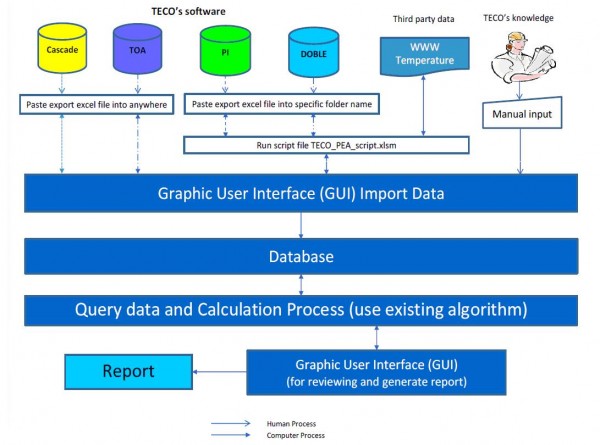U.S., Thai Utilities Partner to Address Asset Health
R. E. Fehr, Ph.D., P.E. – Senior Member
C. A. Steele, P.E. – Member
Understanding asset health is becoming increasingly critical as the utility infrastructure ages. Building an asset health model is complicated, and requires a great deal of expertise, experience, and time. Utilities today are staffed much leaner than they were 20-30 years ago. As a result, the time and effort required to develop a comprehensive asset health model is difficult to find. A Florida utility found an innovative solution to the problem of limited human resources to complete such a critical special project.
Tampa Electric Company (TECO), a TECO Energy company, working with Power System Training, LLC (PST), a training company based in Monroeville, PA, partnered with a team of engineers from Provincial Electricity Authority (PEA) of Bangkok, Thailand to develop a software-based asset health model for distribution transformers, autotransformers, and generator step-up transformers. Two groups of eight PEA engineers were attending long-term training at PST to help them develop methods of implementing reliability improvement programs utilizing data obtained from intelligent devices such as microprocessor-based relays. As part of that training, they requested on-the-job training with a utility to put their newly-learned techniques to practice.
Christopher Steele, TECO’s manager of Substation Operations, and Ralph Fehr, member of the University of South Florida Electrical Engineering faculty and instructor for PST, developed an ambitious scope of work, requiring over one and a half man-years of labor to complete, which would result in a comprehensive software-based system. This system, based on a wide variety of equipment data stored in multiple databases, would produce an asset health score which would serve as a primary decision-making tool for scheduling maintenance. This program also provided the information as to how the score was generated.
The first group of eight PEA engineers worked for six weeks to begin the project (Phase 1). The Phase 1 engineers were successfully able to complete the asset health algorithm which formed the basis for the asset health scoring model. The second group of eight PEA engineers finished the project in an additional five weeks (Phase 2) by completing user interfaces and creating software tools to facilitate data entry. In all, over 3000 man-hours were expended to complete the project, which was part of the overall PST training program. Neither TECO nor PEA incurred costs above the cost of the training, but both utilities enjoyed the benefits of using the new system as a key part of their operations programs.
The software system developed produced a transformer health index score for each transformer in the TECO fleet. The data to generate the health index came from both existing databases and manual input. Quantitative data from existing databases included loading data from PI – Process Book, transformer power factor testing results (Doble), transformer oil analyses, and asset management data from TECO’s asset maintenance system (DNV-GL Cascade). Additionally, qualitative data assessing the general condition of the transformer was gathered from monthly inspections and input. Ambient temperature data was also obtained from weather service observations and was incorporated.
Microsoft Excel macros were used to import and process raw data. Microsoft Access was used to query databases and to perform calculations. A user-friendly graphical user interface was developed to facilitate data entry. Loss of life calculations were done in accordance with IEEE C57.91-2011.
In addition to utilizing existing information, the PEA engineers recommended collecting and incorporating additional data in the future, including fault magnitude and duration data from microprocessor relays to assess the impact of through faults, per IEEE C57.109-1993.
According to TECO’s Steele, “This project truly shows the value of utility collaboration. The value added not only to Tampa Electric but for the engineers going back to PEA is invaluable. This experience will allow these engineers to take back practices learned in the US and apply them at PEA. I truly enjoyed the time with each of the groups and am looking forward to continuing the partnership with PST & PEA. We learned just as much as they did through this experience.”
PST’s Fehr adds, “The classroom training provided the PEA engineers with theory that will be very useful in allowing them to develop and implement measures to increase reliability and decrease costs, but the opportunity to work with TECO engineers and to build this asset health model not only solidifies the theory but also demonstrates their ability to implement the theory. The knowledge gained and shared during the development of the asset health model is proving to be a great benefit for all parties involved.”
While there are many logistical and organizational risks to overcome for a project like this to be successful, the benefits of such a joint venture far exceed the risks. “In a perfect world, TECO could simply hire a team of engineers to implement a project such as this, but limited resources are a reality,” says Fehr. Steele adds, “By working with a utility like PEA, both companies grow their internal capital, thus justifying a project like this and solidifying future endeavors as opportunities present themselves.”
For more information on this joint venture, contact Ralph Powell of Power System Training, LLC at pet.rpowell@aol.com, Ralph Fehr at r.fehr@ieee.org, or Chris Steele at casteele@tecoenergy.com.


